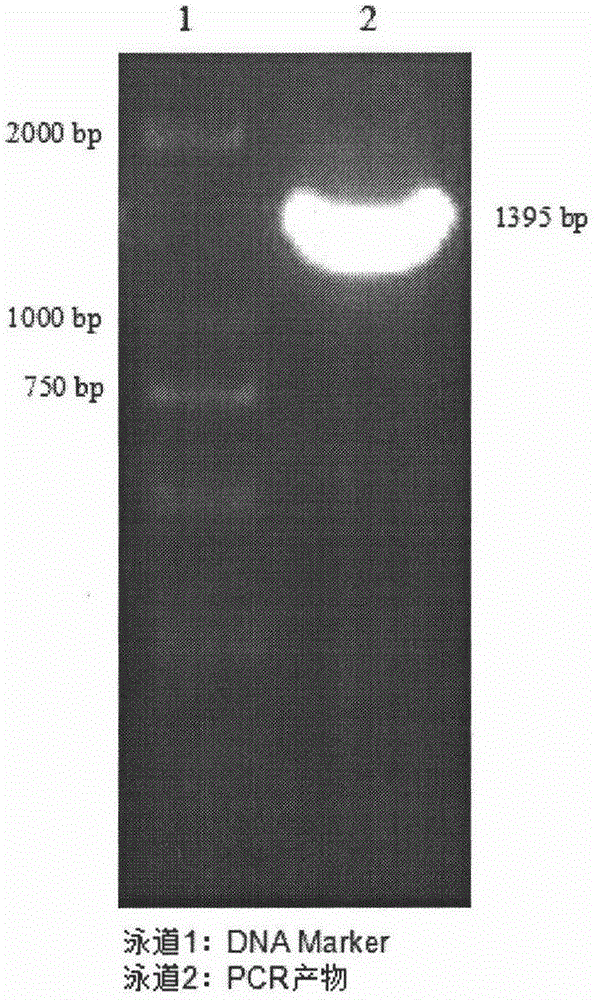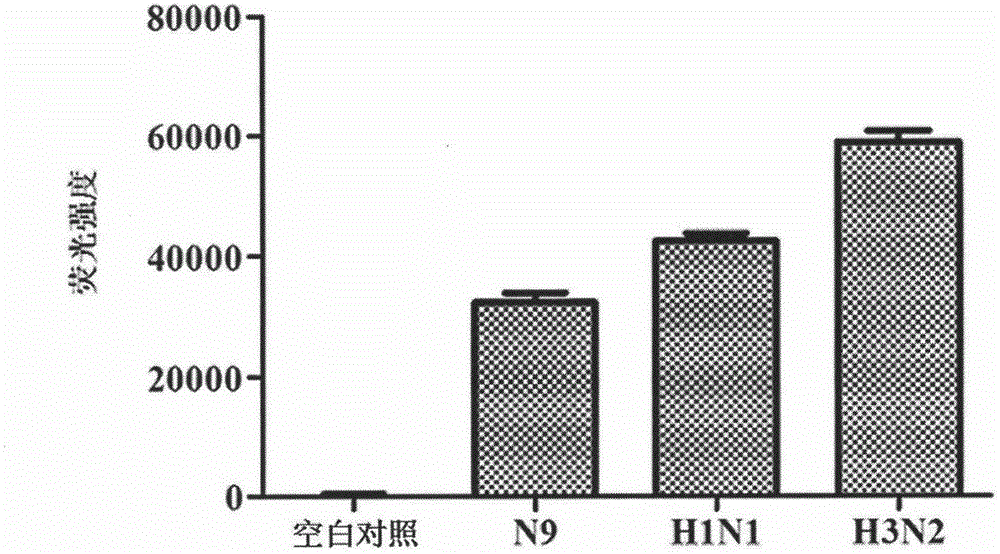Application of AIV (avian influenza virus) H7N9 NA (neuraminidase) inhibitor
A bird flu virus and neuraminidase technology, applied in antiviral agents, medical preparations containing active ingredients, organic active ingredients, etc., can solve problems such as high price, low oral availability, and small volume of distribution
- Summary
- Abstract
- Description
- Claims
- Application Information
AI Technical Summary
Problems solved by technology
Method used
Image
Examples
Embodiment 1
[0016] Expression of influenza virus A / Anhui / 1 / 2013 (H7N9) neuraminidase
[0017] Obtain the gene sequence of influenza virus A / Anhui / 1 / 2013 (H7N9) neuraminidase from the database GISAID (Global Initiative on Sharing Avian Influenza Data) (serial number: EPI439509), and optimize its codons to make it suitable Highly expressed in CHO-K1 cells. The gene sequence is artificially synthesized, named N9, digested by Hind III and Xho I, the digested product is ligated into pcDNA 3.1(+) plasmid digested with the same digestion, and the ligated product is transformed into TOP10 competent cells and coated Amp icillin resistant plate was cultured for 14-18 hours, and a single colony was picked. After the colony was amplified by shaking flask culture, the plasmid was extracted and identified by restriction enzyme digestion, and the cloned neuraminidase gene was sequenced. The recombinant plasmid was identified by double enzyme digestion and expressed in CHO-K1 cells, and a stable cell line ...
Embodiment 2
[0023] Expression of mutant influenza virus A / Anhui / 1 / 2013 (H7N9) neuraminidase
[0024] In the influenza virus A / Anhui / 1 / 2013 (H7N9) neuraminidase gene sequence, arginine 294 was mutated to lysine, and the gene was named N9-R294K. The recombinant expression plasmid pCDNA3.1(+)-N9-R294K was constructed, and a stable cell line was constructed to prepare recombinant neuraminidase N9-R294K. The method is the same as above.
[0025] The results are attached Figure 4 , 5, 6, Figure 4 It showed that the recombinant plasmid pCDNA3.1(+)-N9-R294K was extracted and detected by 1% agarose gel electrophoresis, and a plasmid with a size of 4.1 kb was obtained. The plasmid pCDNA3.1(+)-N9-R294K was double digested with restriction endonucleases Hind III and Xho I, and a 1395bp gene fragment was obtained, which was sequenced. The sequencing result was completely consistent with the sequence of gene N9-R294K , Indicating that the recombinant plasmid pCDNA3.1(+)-N9-R294K was successfully constru...
Embodiment 3
[0027] Inhibition of baicalin on N9 neuraminidase activity
[0028] A 96-well blackboard was used in the experiment, and baicalin was dissolved in PBS and diluted to 500, 250, 125, and 62.5 μM. Add 35μl of MES buffer to each well, add 30μl of recombinantly expressed influenza virus A / Anhui / 1 / 2013(H7N9) neuraminidase solution, and then add 10μl of baicalin of different concentrations, and incubate at 37°C for 5 min. For light operation, add 25μl of neuraminidase specific fluorescent substrate MUNANA to each well, incubate at 37°C for 20min, and finally add 100μl of stop solution 150μl (14mmol / 1 NaOH solution, containing 83% ethanol) to each well. Fluorescence microplate reader measures fluorescence at excitation wavelength 360nm and emission wavelength 440nm. Calculate the inhibition rate of baicalin on neuraminidase activity. The experiment also set up a blank control group without drugs. Inhibition rate of neuraminidase enzyme activity = (fluorescence value of blank control g...
PUM
 Login to View More
Login to View More Abstract
Description
Claims
Application Information
 Login to View More
Login to View More - R&D
- Intellectual Property
- Life Sciences
- Materials
- Tech Scout
- Unparalleled Data Quality
- Higher Quality Content
- 60% Fewer Hallucinations
Browse by: Latest US Patents, China's latest patents, Technical Efficacy Thesaurus, Application Domain, Technology Topic, Popular Technical Reports.
© 2025 PatSnap. All rights reserved.Legal|Privacy policy|Modern Slavery Act Transparency Statement|Sitemap|About US| Contact US: help@patsnap.com



